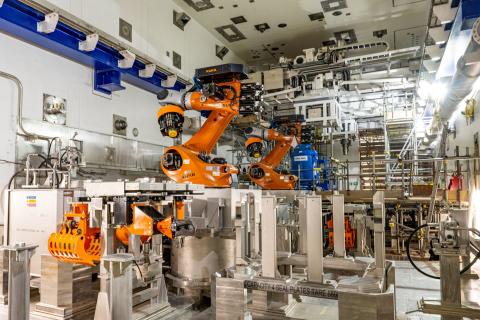-

Robots in BEP's Waste Treatment Cell
-

A waste skip from the Magnox Swarf Storage Silo sits underneath BEP's Gamma Gate
Images courtesy of Sellafield Ltd
Jacobs is helping to deliver a vital project to deal with some of the U.K.'s highest hazard legacy waste.
The $1.9 billion (£1.5 billion) Box Encapsulation Plant (BEP) will be a brand new facility to safely process and store radioactive waste from ponds, silos and other facilities that supported reprocessing missions on the Sellafield site in Cumbria, England.
BEP’s waste treatment cell (WTC) will be a fully remote processing and repacking hub, equipped with state-of-the-art KUKA robots, where waste will be handled in an environment too radioactive to allow any human access.
In March 2024, the WTC was handed over ahead of schedule for commissioning, completing the project’s biggest milestone to date.
"The BEP facility will be vital in supporting delivery of the Sellafield vision by taking waste from the site's legacy facilities and packaging it for interim storage and final disposal," says BEP Project Director Bill Holmes. "Achieving this milestone was a challenge as it includes not only handover of the WTC but many associated systems and rooms. This is effectively many milestones rolled into one and success is purely down to the dedication and skill of the project team."
Major Projects Director for Sellafield Ltd Andy Sharples adds: “This is an incredible achievement and the BEP team deserve a lot of credit for the commitment and hard work in ensuring we deliver this milestone. I can’t thank the team enough and I hope they take great pride in the fact that, even when challenges arose, they didn’t take their eye off the mission, safely and professionally getting the project to this point."
The next part of the plant due for handover is the Box Operations Cell, a central hub for receiving, preparing and distributing waste containers.
BEP is being designed and built by a joint venture comprising Jacobs, site license holders Sellafield Ltd and construction group Balfour Beatty. When fully operational, it will receive legacy waste from across the Sellafield site in various types of import skips before recovering, identifying and grouting the processed waste into three-meter cubed boxes ready to be transferred for interim storage.
Designing BEP was especially challenging because of the need to nuclearize commercial off-the-shelf robots so that they can operate in unstructured environments. The highest possible level of reliability is required because humans will not be able to enter the treatment cell once it begins operations. The robots will work in automated mode and will also be controlled from a distance by operators viewing the cell on CCTV cameras. The robots have to be highly dexterous to process the waste and ensure the boxes are safely grouted ahead of storage.
A pioneer for the U.K.’s nuclear industry, Sellafield supported national defense, generated electricity for nearly half a century and developed the ability to safely manage nuclear waste – delivering great benefit, while also creating a complex nuclear cleanup challenge for which there aren’t any blueprints. Jacobs has worked for more than 40 years to guide Sellafield’s safe decommissioning, waste management and environmental remediation.












































